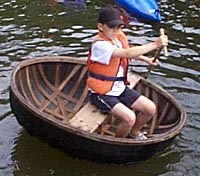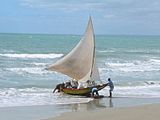Coracle

The coracle is a small, lightweight boat of the sort traditionally used in Wales but also in parts of Western and South West England, Ireland (particularly the River Boyne),[1] and Scotland (particularly the River Spey); the word is also used of similar boats found in India, Vietnam, Iraq and Tibet.[2] The word "coracle" comes from the Welsh cwrwgl, cognate with Irish and Scottish Gaelic currach, and is recorded in English as early as the sixteenth century. Other historical English spellings include corougle, corracle, curricle and coricle.
Structure
Oval in shape and very similar to half a walnut shell, the structure is made of a framework of split and interwoven willow rods, tied with willow bark. The outer layer was originally an animal skin such as horse or bullock hide (corium),[3] with a thin layer of tar to make it fully waterproof – today replaced by tarred calico or canvas, or simply fibreglass. The Vietnamese/Asian version of the coracle is made somewhat differently: using interwoven bamboo and waterproofed by using resin and coconut oil.[4] The structure has a keel-less, flat bottom to evenly spread the weight of the boat and its load across the structure and to reduce the required depth of water – often to only a few inches, making it ideal for use on rivers.
Each coracle is unique in design, as it is tailored to the river conditions where it was built and intended to be used. In general there is one design per river, but this is not always the case. The Teifi coracle, for instance, is flat-bottomed, as it is designed to negotiate shallow rapids, common on the river in the summer, while the Carmarthen coracle is rounder and deeper, because it is used in tidal waters on the Tywi, where there are no rapids. Teifi coracles are made from locally harvested wood – willow for the lats (body of the boat), hazel for the weave (Y bleth in Welsh – the bit round the top) – while Tywi coracles have been made from sawn ash for a long time. The working boats tend to be made from fibreglass these days. Teifi coracles use no nails, relying on the interweaving of the lats for structural coherence, whilst the Carmarthen ones use copper nails and no interweaving.
They are an effective fishing vessel because, when powered by a skilled person, they hardly disturb the water or the fish, and they can be easily manoeuvred with one arm, while the other arm tends to the net; two coracles to a net. The coracle is propelled by means of a broad-bladed paddle, which traditionally varies in design between different rivers. It is used in a sculling action, the blade describing a figure-of-eight pattern in the water. The paddle is used towards the front of the coracle, pulling the boat forward, with the paddler facing in the direction of travel.[5]
Another important aspect to the Welsh Coracle is that it can be carried on his back by one person. 'Llwyth dyn ei gorwgl' — the load of a man is his coracle. (Welsh saying).
History
Designed for use in the swiftly flowing streams of Wales and parts of the rest of Britain and Ireland, the coracle has been in use for centuries, having been noted by Julius Caesar[3] in his invasion of Britain in the mid first century BC, and used in his campaigns in Spain. Remains interpreted as a possible coracle were found in an Early Bronze Age grave at Barns Farm near Dalgety Bay, and two others have been described, from Corbridge and from near Ferriby.[6]
According to Ian Harries, coracle fisherman, coracles are so light and portable that they can easily be carried on the fisherman's shoulders when proceeding to and from his work. Coracle fishing is performed by two coraclers. Where fishing is performed by two people, there is one fisherman per coracle. The net is stretched across the river between the two coracles (the coracler will paddle one handed, dragging the net in the other) and drawn downstream. When a fish is caught, each hauls up an end of the net until the two coracles are brought to touch, and the fish is then secured, using a priest (or knocker – a small block of wood) to stun the fish.
Today
Coracles are now seen regularly only in tourist areas of West Wales, and irregularly in Shropshire on the River Severn – a public house in Sundorne, Shrewsbury called "The Coracle" has a pub sign featuring a man using a coracle on a river. The Welsh Rivers Teifi and Tywi are the best places to find coracles in Wales, although the type of coracle differs depending on the river. On the Teifi they are most frequently seen between Cenarth, and Cilgerran and the village of Llechryd.
In 1974 a Welsh coracle piloted by Bernard Thomas of Llechryd crossed the English Channel to France in 13½ hours. The journey was undertaken to demonstrate how the Bull Boats of the Mandan Indians of North Dakota could have been copied from coracles introduced by Prince Madog in the 12th century.[7]
For many years until 1979, Shrewsbury coracle maker Fred Davies achieved some notability amongst football fans; he would sit in his coracle during Shrewsbury Town FC home matches at Gay Meadow, and retrieve stray balls from the River Severn. Although Davies died in 1994, his legend is still associated with the club.[8]
The Coracle Society
The Coracle Society is a UK-based organisation, founded by its president, Sir Peter Badge in 1990. The five founding aims of the Society were:
- To promote the knowledge of coracles, curraghs and allied craft, their making and use, and also their study and collection,
- To take all reasonable steps to support the continuance of fishing involving the use of coracles and to encourage the holding of coracle regattas, races and the like,
- To publish a newsletter as a means of communication between all those interested in coracles,
- To use its best endeavours to obtain supplies of materials for the construction of coracles, and
- To promote demonstrations, courses, exhibitions, discussions and lectures relating to coracles.[9]
There are many Society members across the country who demonstrate at events and/or run coracle building courses. Terry Kenny, the current chairman of the Society, runs several courses each year at the Green Wood Centre. This year, the Society will be represented at over thirty events and courses – a list of some of this year's events can be found on the official Coracle Society website.
The Society was present at the 2005 Shrewsbury River Festival, where they displayed various coracles on the River Severn. There is also an Annual Coracle Regatta held in Ironbridge on the August Bank Holiday Monday every year. It is organised by the Green Wood Centre and is run on an informal basis whereby anyone with a coracle can take part in the event. Each year new entrants come with coracles made on the Bank Holiday weekend at the Green Wood Centre with local coracle maker Terry Kenny.
The third Coracle Challenge, which raises funds in support of Macmillan Cancer Support took place in Shrewsbury on 19 May 2009, with Terry Kenny participating on behalf of the Society.[10][11]
In 2010, the Society celebrated its 20th anniversary with a number of events planned to recognise this important milestone, including a morning of talks at the National Coracle Centre in Cenarth.
Safety
The design of the craft, as explained above, makes the coracle an unstable craft. Because it sits "on" the water, rather than "in" it, the vessel can easily be carried by currents and the wind. The Coracle Society has published guidelines for safely using coracles.[12]
Similar craft
The oldest instructions yet found for construction of a coracle are contained in precise directions on a four thousand-year-old cuneiform tablet supposedly dictated by the Mesopotamian god Enki to Atra-Hasis on how to build a round "ark". The tablet is about 2,250 years older than previously discovered accounts of flood myths, none of which contain such details.[13] The earliest known written evidence of a coracle-type boat (quffa), still in use today, is in the Bible, Exodus 2:3.
The Irish curach (also currach or curragh) is a similar, but larger, vessel still in use today. Curachs were also used in the west of Scotland:
- "The curach or boat of leather and wicker may seem to moderns a very unsafe vehicle, to trust to tempestuous seas, yet our forefathers fearlessly committed themselves in these slight vehicles to the mercy of the most violent weather. They were once much in use in the Western Isles of Scotland, and are still found in Wales. The framework [in Gaelic] is called crannghail, a word now used in Uist to signify a frail boat." Dwelly's [Scottish] Gaelic Dictionary[14]
The currachs in the River Spey were particularly similar to Welsh coracles. Other related craft include:
- India – parisal
- Iraq – gufa, guffa or quffa
- Native American societies – bull boat
- Tibet – ku-dru and kowas
- Vietnam – thung-chai
See also
References
- ^ Evans, E. Estyn (2000). Irish Folk Ways. Courier Dover Publications. p. 233. ISBN 978-0-486-41440-9.
- ^ The coracle, an ancient little boat
- ^ a b Chisholm, Hugh, ed. (1911). . Encyclopædia Britannica (11th ed.). Cambridge University Press.
- ^ Fagan, Brian M. (2004). The Seventy Great Inventions of the Ancient World. Thames & Hudson. ISBN 0-500-05130-5.
- ^ The Nature of a Coracle
- ^ Watkins, Trevor et al. The Excavation of An Early Bronze Age Cemetery at Barns Farm, Dalgety, Fife, Proc Soc Antiq Scot, 112 (1982) 48–141, page 119, associated with a late Beaker, and a possible radiocarbon date of 1846 BC + or − 80 years (SRR-528) on page 52. The excavation of an Early Bronze Age cemetery at Barns Farm, Dalgety, Fife. Trevor Watkins. With contributions by Mrs Lin Barnetson, Miss A S Henshall, Dr Dorothy Lunt, Ms Ellen McAdam, Mrs Fiona Roe, Alan Shepherd and Dr C C McCawley
- ^ Wales on Britannia: Facts About Wales & the Welsh
- ^ Gentlemen of the River by Phyllis Blakemore. Stenlake Publishing ISBN 978-1-84033-473-9
- ^ The Coracle Society constitution
- ^ Coracle Society events listings
- ^ The Coracle Maker – Calendar of events
- ^ Coracle Society safety guidelines
- ^ Gabrielle Jonas (28 January 2014). "Noah's Ark Was Round, Based On 4,000-Year-Old Mesopotamian Instructions That Are 'Mathematically Accurate'". International Science Times. Archived from the original on 4 March 2014. Retrieved 4 March 2014.
Four thousand-year-old cuneiform instructions on how to build a round "Noah's ark" have turned out to be mathematically on-target, the British Museum curator who translated the text told the International Science Times Monday.
- ^ http://www.dwelly.info/index.aspx
External links
- The official website of The Coracle Society
- The National Coracle Centre at Cenarth Falls
- The Coracle Maker – website of coracle maker Terry Kenny
- World of Coracles website
- BBC Legacies – Coracles article
- World of Boats (EISCA) Collection ~ Parisal from Tamil Nadu, Southern India
- Coracle ferries in Hampi
- Historical note from the Coracle Society of Wales
- Brief history and design principles
- Coracle making courses at Green Wood Centre
- The Welsh Coracle
- Coracle-making courses at Assington Mill, Suffolk
- Annual Coracle Regatta








